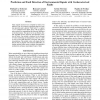Free Online Productivity Tools
i2Speak
i2Symbol
i2OCR
iTex2Img
iWeb2Print
iWeb2Shot
i2Type
iPdf2Split
iPdf2Merge
i2Bopomofo
i2Arabic
i2Style
i2Image
i2PDF
iLatex2Rtf
Sci2ools
AAAI
2012
2012
Prediction and Fault Detection of Environmental Signals with Uncharacterised Faults
Many signals of interest are corrupted by faults of an unknown type. We propose an approach that uses Gaussian processes and a general “fault bucket” to capture a priori uncharacterised faults, along with an approximate method for marginalising the potential faultiness of all observations. This gives rise to an efficient, flexible algorithm for the detection and automatic correction of faults. Our method is deployed in the domain of water monitoring and management, where it is able to solve several fault detection, correction, and prediction problems. The method works well despite the fact that the data is plagued with numerous difficulties, including missing observations, multiple discontinuities, nonlinearity and many unanticipated types of fault.
| Added | 29 Sep 2012 |
| Updated | 29 Sep 2012 |
| Type | Journal |
| Year | 2012 |
| Where | AAAI |
| Authors | Michael A. Osborne, Roman Garnett, Kevin Swersky, Nando de Freitas |
Comments (0)

